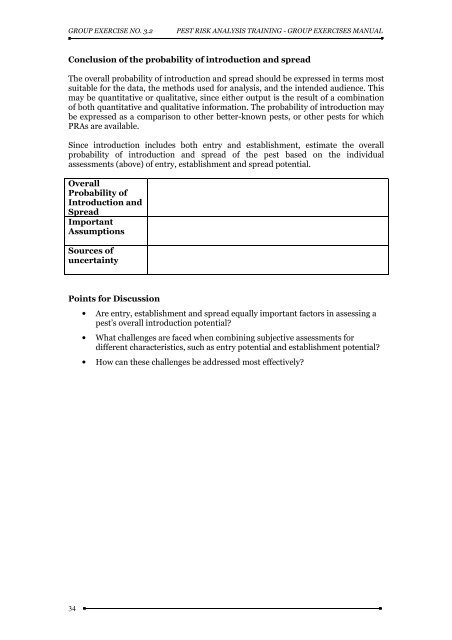PEST RISK ANALYSIS (PRA) TRAINING Group Exercises Manual
PEST RISK ANALYSIS (PRA) TRAINING Group Exercises Manual
PEST RISK ANALYSIS (PRA) TRAINING Group Exercises Manual
Create successful ePaper yourself
Turn your PDF publications into a flip-book with our unique Google optimized e-Paper software.
GROUP EXERCISE NO. 3.2<br />
<strong>PEST</strong> <strong>RISK</strong> <strong>ANALYSIS</strong> <strong>TRAINING</strong> - GROUP EXERCISES MANUAL<br />
Conclusion of the probability of introduction and spread<br />
The overall probability of introduction and spread should be expressed in terms most<br />
suitable for the data, the methods used for analysis, and the intended audience. This<br />
may be quantitative or qualitative, since either output is the result of a combination<br />
of both quantitative and qualitative information. The probability of introduction may<br />
be expressed as a comparison to other better-known pests, or other pests for which<br />
<strong>PRA</strong>s are available.<br />
Since introduction includes both entry and establishment, estimate the overall<br />
probability of introduction and spread of the pest based on the individual<br />
assessments (above) of entry, establishment and spread potential.<br />
Overall<br />
Probability of<br />
Introduction and<br />
Spread<br />
Important<br />
Assumptions<br />
Sources of<br />
uncertainty<br />
Points for Discussion<br />
• Are entry, establishment and spread equally important factors in assessing a<br />
pest’s overall introduction potential?<br />
• What challenges are faced when combining subjective assessments for<br />
different characteristics, such as entry potential and establishment potential?<br />
• How can these challenges be addressed most effectively?<br />
34













